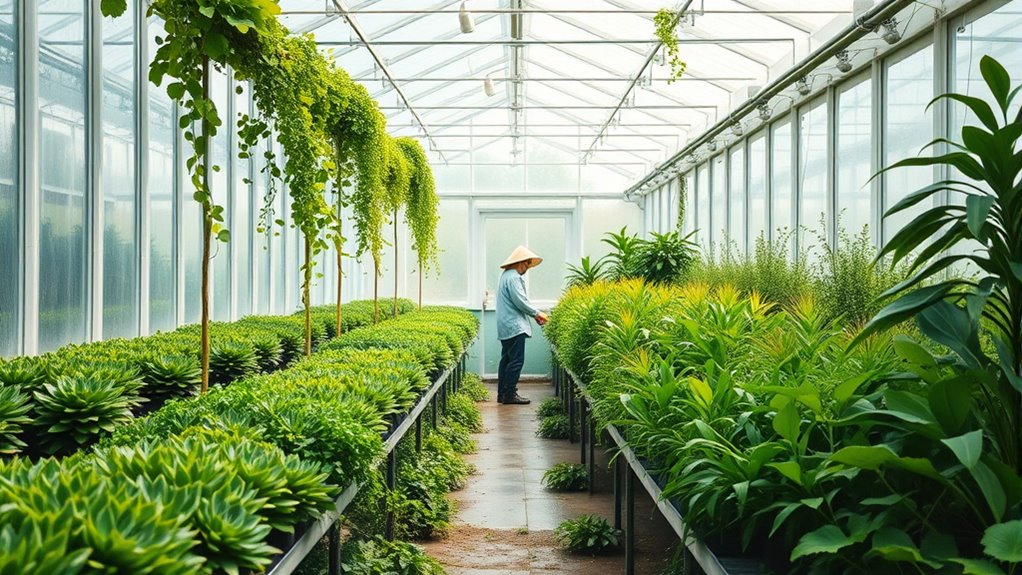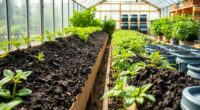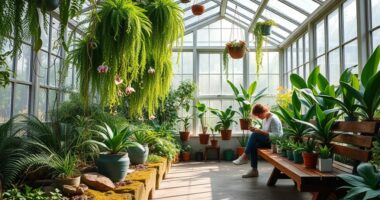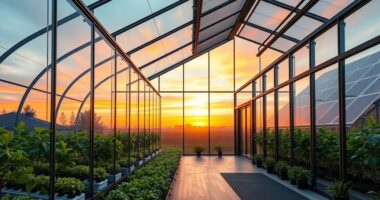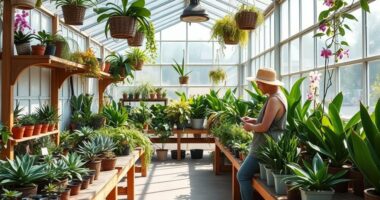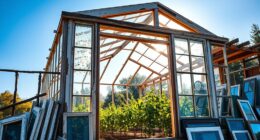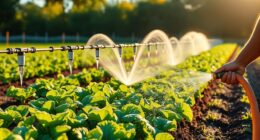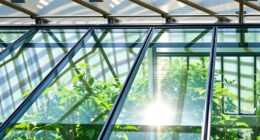Greenhouse tours let you see how experienced growers optimize plant health through practical setups, innovative techniques, and management strategies. You’ll observe different configurations for pest control, propagation, and climate management that suit various crops. These visits help you learn how to adapt tools and systems for your own needs. By paying attention to these setups, you can pick up tips for success and explore how adjustments lead to healthy, thriving plants. Keep going to discover even more insights.
Key Takeaways
- Observe diverse greenhouse configurations to understand how setup choices impact plant health and growth.
- Learn propagation techniques and environmental controls used by experienced growers.
- Identify pest management strategies, including biological controls and physical barriers.
- Gain insights into monitoring methods and how growers adapt setups for different crops.
- Discover practical tips on optimizing space, tools, and environment for successful plant cultivation.

Greenhouse tours offer a fascinating glimpse into the world of cultivated plants and horticultural innovation. As you walk through these lush environments, you’ll see firsthand how experienced growers optimize every aspect of plant care, from propagation to pest management. Observing different setups allows you to pick up practical tips and see how theory translates into effective practice.
One key aspect you’ll notice is how growers handle plant propagation. They often use specific techniques suited to different plant species, such as seed starting, cuttings, or grafting. You’ll see how carefully controlled environments—like humidity chambers or misting systems—create ideal conditions for seedlings and cuttings to develop roots. This process isn’t just about nurturing young plants but also about maximizing success rates with minimal waste. By watching how others manage propagation, you gain insights into timing, media choices, and the importance of maintaining clean, sterile conditions to prevent disease.
Observing propagation techniques reveals how controlled environments maximize success and prevent disease.
Pest management is another critical element you’ll observe during your tour. Growers have developed integrated strategies that combine biological controls, physical barriers, and careful monitoring to keep pests at bay. You might see insect screens on vents, sticky traps, or natural predators introduced to control problematic insects. These methods reduce reliance on chemical pesticides, making the environment safer for both plants and people. Noticing how growers regularly inspect plants for early signs of pests teaches you the importance of vigilance and prompt action. They often employ preventative measures, such as crop rotation and sanitation, to minimize pest outbreaks before they escalate. Additionally, many growers leverage advanced monitoring techniques to detect issues early and respond more effectively.
Seeing these practices in action helps you understand that effective plant propagation and pest management require ongoing attention and adaptation. The growers you observe have tailored their setups based on their specific crops and local conditions, demonstrating that there’s no one-size-fits-all solution. Instead, they show you that success depends on careful observation, timely intervention, and utilizing the right tools. Whether it’s setting up propagation stations to produce new plants or implementing pest barriers to protect mature crops, these setups are designed to optimize growth and health.
Frequently Asked Questions
How Do I Schedule a Greenhouse Tour Near Me?
To schedule a greenhouse tour near you, start by searching local botanical gardens or nursery websites that often offer guided visits. Contact them directly via phone or email to inquire about available dates, focusing on their garden layout and plant varieties. Many places require advance booking, so plan ahead. You can also check community boards or social media groups for upcoming tours or special events related to plant varieties and greenhouse design.
Are There Any Costs Associated With Greenhouse Tours?
You might worry about costs, but many greenhouse tours are free or have minimal tour costs. Some places charge tour booking fees, especially for special or private visits, but others offer complimentary tours to educate visitors. It’s best to check with the specific greenhouse beforehand. Usually, the benefits of learning firsthand about sustainable practices or innovative setups outweigh any small tour costs or booking fees involved.
Can I Photograph or Record During the Tour?
You can usually photograph or record during the tour, but it’s essential to verify the photo permissions and recording policies beforehand. Some greenhouses may restrict certain areas or require permission to avoid disturbing staff or other visitors. Always ask the tour guide or staff about their policies on photography and recording to ensure you respect their rules and avoid any issues. Following these guidelines helps you capture memories responsibly.
Do Tours Accommodate Special Needs or Group Visits?
Think of a greenhouse tour as a garden where everyone’s invited to blossom. Yes, they do accommodate special needs and group visits, making sure accessible facilities are in place for all. Whether you’re with a large group or have specific requirements, the staff works to create a welcoming environment. Just let them know your needs in advance, and they’ll make certain your experience is as smooth as a well-tended vine.
What Should I Bring or Wear for the Tour?
You should dress comfortably and wear appropriate footwear, like sturdy shoes or sneakers, to handle uneven or damp surfaces. Bring a hat, sunglasses, and sunscreen if it’s sunny, and consider a light jacket if it’s cool inside or outside. Don’t forget a water bottle to stay hydrated. Wearing layers helps you stay comfortable as temperature conditions change throughout the tour. These preparations make certain you enjoy the experience fully.
Conclusion
Seeing how others set up their greenhouses offers valuable insights you can adapt for your own space. For example, imagine visiting a local greenhouse where efficient watering systems and space-saving shelving boost productivity. By observing their setup, you might realize that adding vertical racks or drip irrigation could transform your garden. Learning from these real-life examples helps you avoid mistakes and sparks ideas, making your greenhouse journey more successful and enjoyable.
